| New Mexico during World War II | |
|---|---|
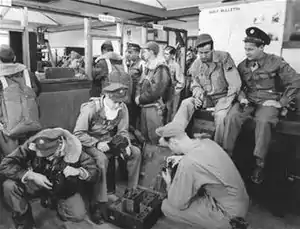 Enlisted men drawing cameras to go up in a Beechcraft AT-11 on bomb-spotting missions at Roswell Army Flying School. | |
| Population | 531,818 (1940) |
| Date | 1941–1945 |
| Casualties | ~2,349 |
| Events | Lordsburg Killings – July 27, 1942 Escape from Fort Stanton – November 1–3, 1942 Bat Bomb Incident – May 15, 1943 Santa Fe Riot – March 12, 1945 Trinity explosion – July 16, 1945 |
The history of New Mexico during World War II is characterized by dramatic and lasting changes to its economy, society, and politics. The state played a central role in the American war effort, contributing a disproportionately high number of servicemen and natural resources;[1] most famously, it hosted the sites where the world's first nuclear weapon was designed, developed, and tested.[2]
When the United States entered World War II in December 1941, New Mexico had been a state for only three decades and was largely marginal in national affairs. Its sparse population, remoteness, and geography proved ideally suited for top secret military bases and scientific laboratories—most notably at Los Alamos, which undertook the advanced nuclear research that led to the atomic bomb.[3] New Mexico also hosted a variety of military installations, from training facilities to army hospitals, as well as several camps for prisoners of war and Japanese American internees.
New Mexicans were among the first Americans to see combat in the war, with over 1,800 fighting Japan's invasion of the Philippines just hours after its attack on Pearl Harbor. Patriotism ran high throughout the state's diverse and disparate populace, including among its long-marginalized Hispanic and indigenous communities; among them were several of the famed Navajo code talkers, who were critical to protecting U.S. wartime communications. New Mexico would provide more military volunteers, and suffer more casualties, than any other state.
World War II had an immediate and enduring transformative effect on New Mexico. Government investment precipitated an unprecedented economic and demographic boom, with the state's pre-war population of 530,000 nearly doubling to 950,000 by 1960. New Mexico's largely agrarian prewar economy became more industrialized, and its mostly rural population became increasingly urban. Many of the military and scientific installations built during the war remain active and strategically valuable to this day; the wartime development of modern military technology fostered a unique and continuing relationship between New Mexico, the federal government, and the scientific community.[4][5][6]
Military personnel
The United States participated in the Second World War from December 1941 to August 1945. During that time, 49,579 New Mexicans volunteered or were drafted into military service, accounting for roughly 9 percent of the total population—the highest rate of service among all forty-eight states at the time.[4] New Mexico also endured the highest proportion of fatalities among U.S. states, losing over 2,200 citizens by the war's end.[7]: 7
Bataan Death March
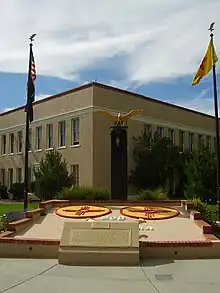
Soldiers from New Mexico were among the first Americans to fight in the war. On January 3, 1941, the 200th Coast Artillery of the New Mexico National Guard had been mobilized for one year's service with the United States Army, arriving in the Philippines in September, where they manned anti-aircraft guns at Clark Field and Fort Stotsenburg.[8] The regiment had a storied history, tracing its origins to the famous New Mexican Cavalry that was deployed to Cuba to fight with Teddy Roosevelt’s "Rough Riders" in the Spanish-American War. When New Mexico became a state less than fourteen years later, in 1912, the cavalry force was federalized and the 200th became one of the most ethnically diverse National Guard battalions in the United States.[9]
The regiment saw action just ten hours after the December 8th attack on Pearl Harbor, Hawaii, when Japanese aircraft led the coming invasion of the Philippines. Although their shells could not hit high-flying Japanese bombers, the New Mexicans managed to strike lower altitude fighters, downing eighty-six aircraft, including six in a single day.[7]: 13 After the Japanese launched their main offensive to conquer the Philippines on January 7, 1942, the 200th Coast Artillery, along with the newly formed 515th Coast Artillery of New Mexico, covered the withdrawal of Filipino and American forces during the Battle of Bataan.
Despite the overwhelming odds working against them, the "New Mexico Brigade"[10] and other defenders continued putting up dogged resistance, surprising Japanese forces, who had expected to capture the Philippines sooner.[7]: 13 However, amid mounting casualties, dwindling ammunition and supplies, and worsening health conditions, American and Filipino surrendered on April 9, 1942; nineteen New Mexicans were killed after nearly four months of fighting.[7]: 13 The survivors joined other captured troops in the infamous Bataan Death March that followed, in which thousands of Allied prisoners of war died during an arduous march from the battlefield to camps at Balanga; thousands died during the nearly two-week trek, due to thirst, hunger, exhaustion, disease, and mistreatment by Japanese troops, including torture and executions. The majority of New Mexicans and their fellow POWs remained in Japanese captivity until the end of the war, with many perishing in camps throughout the Philippines as well as in hell ships that transported them in inhumane conditions across the Japanese Empire to serve as forced labor.
On December 8, 1941, when the Japanese unexpectedly attacked the Philippine Islands, the first point bombed was Ft. Stotsenberg. The 200th Coast Artillery, assigned to defend the Fort, was the first unit, under The General of the Army Douglas MacArthur, to go into action defending our flag in the Pacific. First to fire, and last to lay down their arms! A fitting epitaph for a valiant Brigade which fought standing firmly in its appointed place and facing forward to the enemy. — U.S. Army General Jonathan Mayhew Wainwright IV[11]
Of the 1,825 New Mexican troops serving in the Philippines, fewer than half, approximately 800 to 900, returned home;[4] of these survivors, an estimated one-third died within a year, most likely due to health complications from their harsh captivity.[12] The infamy of the Bataan Death March, and its accounting for half New Mexico's war dead, has led to it being heavily memorialized in the state. Monuments and statues dedicated to Bataan are found in most major cities and towns, including Taos, Las Cruces, Roswell, and Deming, where a disproportionate number of residents served with the 200th Coast Artillery; the largest commemorative site is Bataan Memorial Park in Albuquerque, which bears inscriptions of the names of all those who served in the Philippines. Several streets, plazas, and government buildings are named after the event, including the Bataan Memorial Building in Santa Fe, which was once the state capitol and today hosts several state agencies.[13]
Navajo code talkers

Many of the famed Navajo code talkers of the Second World War came from New Mexico. Seeking a way to protect communications from Japanese intelligence, the Marine Corps raised several outfits of Navajo radiomen who could use their native language as a code on the battlefield. The first group, which consisted of twenty-nine men, was recruited by Philip Johnston, a World War I veteran who was fluent in the Navajo language. Johnston and the "original twenty-nine," as they were known, are credited with developing the code, though it was modified and improved by others as the war progressed. At least 540 Navajos served in the Marine Corps during World War II, about 400 of whom were trained as code talkers. Because many of them lacked birth certificates, it was impossible to verify the age of some recruits; after the war, it was revealed that boys as young as fifteen had enlisted. Navajo code talkers fought in every major campaign of the Pacific Theater between 1942 and 1945, from Guadalcanal to Okinawa. They are credited with saving countless lives and hastening the war's end with their simple transmissions; their code was never broken and continued to be used by American forces during the Korean War and at the beginning of the Vietnam War.[4][14][15][16][17]
Medal of Honor recipients
Eight New Mexicans—five native-born and three who had moved to the state—were awarded the U.S. Armed Forces' highest military decoration, the Medal of Honor, for distinguished acts of valor during World War II. Of these recipients, five were posthumously recognized;[7]: 89 they include Joe P. Martínez of Taos, the first Hispanic American recipient, for actions in the Aleutian Islands Campaign; Harold Herman Moon, Jr. of Albuquerque, for actions during the Battle of Leyte in the Philippines; and Jose F. Valdez of Gobernador, for actions in German-occupied France.
Military installations
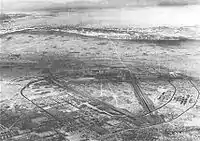

Several military installations were built in New Mexico just after the war began, including airbases, training facilities, prisoner of war camps and internment camps. Among the most prominent of the new bases was Kirtland Field, in Albuquerque. Kirtland was originally an advanced flight school for Air Corps pilots, but it was converted into a major base shortly after the attack on Pearl Harbor. By the end of the war, 1,750 B-24 crewmen had trained there, as well as B-29 pilots, AT-11 pilots, glider pilots, aviation mechanics, navigators, and others. In May 1942, the army built the Albuquerque Air Depot Training Station just east of Kirtland to specialize in training in aircraft service, repair, and maintenance; however, shortly thereafter, it was transformed into an airbase and used as a convalescence station for wounded soldiers returning from battle. In 1945, the facility was renamed Sandia Army Airfield and eventually merged with Kirtland. Other major bases were located at Clovis, Alamogordo, and Roswell, along with temporary war-time airfields at Hobbs, Deming, Fort Sumner, and the White Sands Proving Ground.[4]
The prisoner of war and internment camps in New Mexico were among the largest in the United States during World War II. Most prisoners were Germans who had been captured during the North Africa Campaign, although there were some Italian soldiers. Among the most notable sites were Camp Roswell, located next to Walker Army Airfield, which housed 4,800 Germans and Italians; Camp Lordsburg, near the town of Lordsburg, which had Germans, Italians, and some 600 Japanese internees; and Camp Santa Fe, near the state's capital city of Santa Fe, which held 1,900 Japanese internees.[4][18][19]
Life at the camps was mostly peaceful and unexciting, however, there was an incident in 1942 involving the shooting deaths of two Japanese internees at Camp Lordsburg, and a "small riot" at Camp Santa Fe in 1945. There was also at least one notable escape attempt. Four sailors, who had been captured aboard the SS Columbus in 1939, slipped out of the German internment camp at Fort Stanton on the night of November 1, 1942. Heading south towards the border with Mexico, the Germans made only fourteen miles before being recaptured by a posse of locals after a brief firefight inside the Lincoln National Forest.[18][20][21]
| Military installations[5] | Total |
|---|---|
| Major Airbases | 8 |
| Dispersal Bases | 5 |
| Bombing & Gunnery Ranges | 13 |
| Army Hospitals | 4 |
| Camps | 2 |
| National Cemeteries | 3 |
| POW Camps | 3 |
| Branch POW Camps | 19 |
| National Guard Armories | 11 |
| Colleges & Universities | 7 |
| Specialized Military Locations | 7 |
Scientific research

New Mexico became a center for advanced, top secret military technology during the war. Several important technological breakthroughs occurred within the state, of which the most famous and decisive was the atomic bombing. Another a major innovation was the proximity fuse, a type of fuse attached to artillery shells that could trigger an explode within the proximity of a target, rather than on impact. Testing of proximity fused anti-aircraft shells was carried out from Kirtland Field as early as 1943; on a desert mesa nearby, the army suspended aircraft with "the tallest wooden towers in the world" to fire the shells at them. The fuses proved pivotal in the Pacific Theater, where they were used with devastating effect against Japanese aircraft, and in the Ardennes campaign against Germany during the 1944 Siege of Bastogne.[5]
Manhattan Project
The most important of all the secret weapons programs in New Mexico was the Manhattan Project, the codename for the nuclear weapons experiments taking place across the United States, Canada, and Britain. It began in 1942 after physicist J. Robert Oppenheimer assembled "the greatest concentration of scientific resources and brainpower in history" to build the world's first atomic bomb. Based on Oppenheimer's proposal for a dedicated bomb laboratory, in 1943 the U.S. government ordered the army to construct the giant Los Alamos National Laboratory in a remote location twenty miles northwest of Santa Fe, then sealed off the entire area to keep it secret.[22] Then known as Project Y, the site was selected for its combination of isolation, relative accessibility, and natural beauty.[23]
By the end of the war in 1945, some 5,000 people lived at Los Alamos, which led to the founding of the present-day town.[4][24][25] The eponymous lab remains a federal facility, serving as one of the largest scientific institutions in the world.[26]
Economy
Despite its reputation as an arid desert, New Mexico's pre-war economy was largely agrarian, centered mainly on cattle ranching and subsistence-level farming. Despite having been heavily weakened by the Great Depression, the state managed to revitalize its farming industry and grow a wide variety of crops for the war effort; among the main agricultural products were carrots, pinto beans, cotton (which was critical for uniforms), beef, and lamb.[7]: 75 Like other western states, New Mexico was a major recipient of Mexican laborers imported into the U.S. through the Bracero Program with Mexico.[27]
New Mexico had long been known for its abundant natural resources, ranging from petroleum to various metals. At the time the U.S. entered World War II, the state had already experienced increased production of copper, lead, zinc, molybdenum, and manganese. The highly mechanized U.S. military was heavily reliant on all types of metals as well as fossil fuels; like many states, New Mexico saw unprecedented investment in its mining and extraction industries, ultimately becoming one of the leading contributors of strategic resources. During the war, the state ranked first in the production of potash (a key ingredient in explosives), tantalum (a major component in electronics and alloys), and pumice (for use in construction); second in zinc and tin; third in copper, molybdenum, and vanadium; fourth in beryl, lithium, and fluorspar; and seventh in oil and gas. In terms of the overall value of minerals produced, New Mexico ranked fourteenth among U.S. states.[28]
Casualties
Roughly four percent of New Mexicans who served in the war were killed or missing—the highest rate of casualties of any state.[29][30] Approximately half of all deaths were attributed to the Bataan Death March and the captivity that followed, in which POWs were subject to inhumane treatment, malnourishment, torture, and summary execution.
Army and Air Forces
| County | Killed in Action (KIA) | Died of Wounds (DOW) | Died of Injuries (DOI) | Died, Non-Battle (DNB) | Finding of Death (FOD) | Missing in Action (MIA) | Total |
|---|---|---|---|---|---|---|---|
| Bernalillo | 160 | 12 | 1 | 163 | 17 | 1 | 354 |
| Catron | 6 | 2 | 4 | 2 | 14 | ||
| Chaves | 58 | 4 | 23 | 7 | 1 | 93 | |
| Colfax | 27 | 4 | 25 | 5 | 61 | ||
| Curry | 29 | 5 | 43 | 5 | 2 | 84 | |
| De Baca | 7 | 3 | 7 | 1 | 18 | ||
| Doña Ana | 53 | 3 | 1 | 28 | 12 | 1 | 98 |
| Eddy | 54 | 6 | 53 | 3 | 116 | ||
| Grant | 55 | 5 | 43 | 3 | 2 | 108 | |
| Guadalupe | 15 | 4 | 10 | 29 | |||
| Harding | 8 | 2 | 3 | 13 | |||
| Hidalgo | 9 | 1 | 4 | 14 | |||
| Lea | 27 | 5 | 29 | 4 | 65 | ||
| Lincoln | 21 | 12 | 1 | 34 | |||
| Luna | 26 | 4 | 1 | 21 | 5 | 1 | 58 |
| McKinley | 51 | 6 | 41 | 5 | 103 | ||
| Mora | 29 | 3 | 9 | 41 | |||
| Otero | 19 | 1 | 15 | 2 | 37 | ||
| Quay | 12 | 4 | 7 | 1 | 24 | ||
| Rio Arriba | 32 | 1 | 20 | 7 | 60 | ||
| Roosevelt | 22 | 3 | 17 | 3 | 45 | ||
| Sandoval | 21 | 4 | 15 | 1 | 41 | ||
| San Juan | 22 | 6 | 14 | 3 | 45 | ||
| San Miguel | 42 | 5 | 22 | 2 | 71 | ||
| Santa Fe | 59 | 6 | 47 | 5 | 117 | ||
| Sierra | 14 | 1 | 7 | 3 | 25 | ||
| Socorro | 23 | 4 | 9 | 36 | |||
| Taos | 36 | 6 | 26 | 1 | 69 | ||
| Torrance | 17 | 4 | 10 | 2 | 33 | ||
| Union | 16 | 1 | 10 | 4 | 31 | ||
| Valencia | 46 | 5 | 31 | 82 | |||
| State at Large | 7 | 3 | 2 | 1 | 13 | ||
| Total | 1,023 | 120 | 3 | 771 | 105 | 10 | 2032 |
Navy, Marine Corps, and Coast Guard
Over half the New Mexicans who served in the maritime forces—the U.S. Navy, Marine Corps, and Coast Guard—were killed in action.[31] Among these fatalities were twenty-four of the eighty-four sailors who died with the sinking of the submarine USS Bullhead, which most likely occurred the same day an atomic bomb was dropped on Hiroshima; it was the last U.S. naval vessel lost to enemy action during World War II.[32] The event is commemorated through Bullhead Memorial Park in Albuquerque, a 44-acre park that includes a memorial featuring three inert World War II-era torpedoes and two plaques bearing the names of the men who died aboard.[33]
| Type | Total |
|---|---|
| Killed in Action (KIA) | 219 |
| Killed in Prison Camps | 5 |
| Missing in Action (MIA) | 7 |
| Wounded in Action (WIA) | 330 |
| Released from Prison Camps | 19 |
| Total | 580 |
Gallery
 Project Bookmobile visiting the school at Llano San Juan to circulate books, show educational films, and sell defense stamps, in December 1941.
Project Bookmobile visiting the school at Llano San Juan to circulate books, show educational films, and sell defense stamps, in December 1941.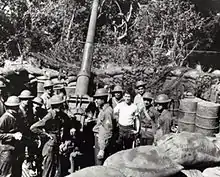 Members of the 200th Coast Artillery during the Philippines Campaign in 1942.
Members of the 200th Coast Artillery during the Philippines Campaign in 1942. Three Pueblo Indians watching tourists at San Ildefonso Pueblo, New Mexico. Photograph taken by Ansel Adams in 1942.
Three Pueblo Indians watching tourists at San Ildefonso Pueblo, New Mexico. Photograph taken by Ansel Adams in 1942. Japanese internees at Camp Lordsburg sometime between 1942 and 1943.
Japanese internees at Camp Lordsburg sometime between 1942 and 1943. A fire at the Carlsbad Army Airfield during the Bat Bomb Incident in 1943.
A fire at the Carlsbad Army Airfield during the Bat Bomb Incident in 1943.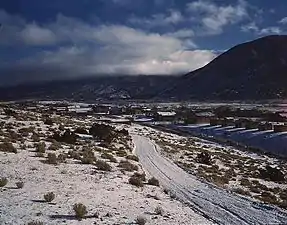 Questa, New Mexico in 1943.
Questa, New Mexico in 1943. A Santa Fe Railroad streamliner, the "Super Chief," being serviced at the depot in Albuquerque in March 1943.
A Santa Fe Railroad streamliner, the "Super Chief," being serviced at the depot in Albuquerque in March 1943. A Boeing B-29 Superfortress at Kirtland Field in 1945.
A Boeing B-29 Superfortress at Kirtland Field in 1945.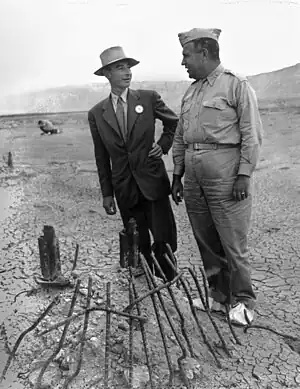 General Leslie Groves and J. Robert Oppenheimer at the site of the Trinity explosion in September 1945.
General Leslie Groves and J. Robert Oppenheimer at the site of the Trinity explosion in September 1945.
See also
References
- ↑ "New Mexico and World War II". HISTORY. Retrieved 2022-12-23.
- ↑ "World War II and New Mexico". Atomic Heritage Foundation. Retrieved 2022-12-09.
- ↑ "Manhattan Project: Establishing Los Alamos, 1942-1943". www.osti.gov. Retrieved 2022-12-09.
- 1 2 3 4 5 6 7 8 Roberts, Susan A.; Calvin A. Roberts (2006). New Mexico. University of New Mexico Press. ISBN 978-0-8263-4003-0.
- 1 2 3 "World War II From a New Mexican Perspective" (PDF). Retrieved November 28, 2012.
- ↑ "census.gov" (PDF). Retrieved November 28, 2012.
- 1 2 3 4 5 6 Melzer, Richard; Taylor, John (2021). Images of America: New Mexico in World War II. Arcadia Publishing. ISBN 1-4671-0670-4. OCLC 1243262138.
- ↑ "National Guard Gets Its Order to Mobilize". Albuquerque Historical Society. Retrieved 2023-01-18.
- ↑ "New Mexico Tells New Mexico History | History: The Great Depression and World War II". online.nmartmuseum.org. Retrieved 2023-01-18.
- ↑ Houghton, Woods. "Column: The 200th and 515th - The New Mexico Brigade". Carlsbad Current-Argus. Retrieved 2023-01-18.
- ↑ Houghton, Woods. "Column: The 200th and 515th - The New Mexico Brigade". Carlsbad Current-Argus. Retrieved 2023-01-18.
- ↑ Houghton, Woods. "Column: The 200th and 515th - The New Mexico Brigade". Carlsbad Current-Argus. Retrieved 2023-01-18.
- ↑ "Central Complex | NM GSD". Retrieved 2023-01-17.
- ↑ "Native American Indian Heritage Month". Retrieved September 26, 2012.
- ↑ "Navajo Code Talkers". Archived from the original on January 15, 2013. Retrieved November 28, 2012.
- 1 2 "Japanese Americans in New Mexico" (PDF). Andrew B. Russel. Retrieved November 28, 2012.
- ↑ "Roswell Web Magazine: Lifestyle Issue 02". Retrieved November 28, 2012.
- ↑ "The Montreal Gazette – Google News Archive Search". Retrieved November 28, 2012.
- ↑ "German Sailors On the High Desert: A World War II German Detainment Camp At Fort Stanton" (PDF). Archived from the original (PDF) on November 9, 2013. Retrieved November 28, 2012.
- ↑ Jones, Vincent (1985). Manhattan: The Army and the Atomic Bomb (PDF). Washington, D.C.: United States Army Center of Military History. OCLC 10913875
- ↑ "50th Anniversary Article: Oppenheimer's Better Idea: Ranch School Becomes Arsenal of Democracy". Los Alamos National Laboratory.
- ↑ "Event/Exhibition Details Museum of New Mexico Media Center :: Events Calendar :: Events Details". Retrieved November 28, 2012.
- ↑ "Los Alamos History of the Manhattan Project". Archived from the original on December 27, 2012. Retrieved November 28, 2012.
- ↑ "Los Alamos National Laboratory (LANL) | UCOP". www.ucop.edu. Retrieved 2022-12-01.
- ↑ "New Mexico Tells New Mexico History | History: The Great Depression and World War II". online.nmartmuseum.org. Retrieved 2023-01-18.
- ↑ Contributions of New Mexico's mineral industry to World War II, New Mexico Tech, compiled by T.D. Benjovsky, Socorro (1947).
- ↑ "Total Losses for New Mexico World War II Casualties Army and Air Force". Retrieved November 28, 2012.
- ↑ "World War II Army Casualties: New Mexico". Retrieved November 28, 2012.
- ↑ "World War II Casualties: New Mexico". Retrieved November 28, 2012.
- ↑ "Memorial to 84 WWII U.S. Sailors Lost Aboard USS Bullhead Unveiled in Australia". USNI News. 2021-08-11. Retrieved 2023-01-18.
- ↑ "Submariners Commemorate Sinking of USS Bullhead - Albuquerque Journal". www.abqjournal.com. Retrieved 2023-01-18.

